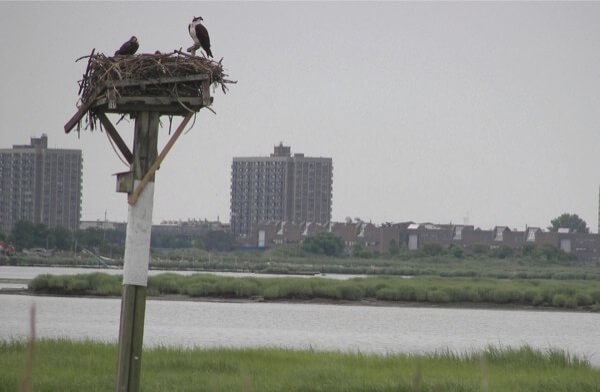By Patrick Donachie
New Yorkers who enjoy Jamaica Bay have seen many potential threats to the area’s marshes in decades past, but Dan Mundy, Jr., the head of the Jamaica Bay Ecowatchers, said the future was bright despite the challenges of protecting it.
“Right now, we feel like the marsh is on an upswing,” he said.
Jamaica Bay separates the Rockaways from Brooklyn and Queens and extends for about 20,000 acres. It is a vibrant environmental habitat, and more than 330 bird species have been seen at the bay’s wildlife refuge within the past 25 years, according to the conservancy for the National Parks of New York Harbor.
Jamaica Bay’s marsh islands have undergone significant environmental degradation despite federal protection enacted in 1972. Since 1924, the bay has lost approximately 1,400 acres of tidal salt marsh, according to the U.S. Army Corps of Engineers.
The Army Corps targeted the marshes for restoration, committing $19 million in 2012 to restore some of the endangered islands. The corps also announced last year that it was exploring how to best mitigate potential damage from a future Sandy-like superstorm. The Ecowatchers have also been concerned the effect that John F. Kennedy International Airport has on the marshes, including unsuccessful proposals to construct additional runways on the bay.
Until 2012, more than 54,000 pounds of nitrogen per day were being dumped into the bay from the Jamaica Wastewater Treatment Plant, as well as from three other city-owned treatment plants. Mundy said the plants were initially unable to remove nitrogen from wastewater to the detriment of the bay. In 2010, the Ecowatchers, in partnership with the Natural Resources Defense Council and other organizations, filed a federal lawsuit against the city, and the city’s Department of Environmental Protection eventually pledged to commit $187 million to improving the treatment plants. In December 2014, the city announced the DEP had completed $83 million in improvements at Jamaica Wastewater Treatment Plant, which Mundy said had a major effect.
“There’s a certain clarity to the water that you see when you put your fishing line down,” he said. “We’re seeing a big increase in the water quality.”
Since the improvements nitrogen levels in the bay have dropped to 25,000 pounds per day from 54,000 — and are continuing to go down.
Bay residents are now looking to new projects, including the ambitious proposals for Sunset Cove, located on Broad Channel, the only inhabited island in the bay. Mundy said there would eventually be a boardwalk across the wetlands, an EcoDock for educational excursions and oyster cages that could be maintained by students and residents.
The first phase of the project will be funded with $4.85 million from a U.S. Department of the Interior grant, along with $500,000 from Transco Williams, which is installing a pipeline in the area and is offsetting their impact by funding environmental protections and the DEC. The second phase, which will include the construction of the boardwalk, will include funding from Gov. Andrew Cuomo’s New York Rising program, Assemblyman Phil Goldfeder (D-Ozone Park) and state Sen. Joseph Addabbo (D-Howard Beach).
This year also saw the release of “Saving Jamaica Bay,” a documentary by filmmakers David Sigal and Dan Hendrick that chronicles the fight to protect the bay from encroaching development and pollutants. The film debuted at this year’s Queens World Film Festival.
Mundy noted that the restoration of the wetlands had benefitted from bipartisan support from elected officials.
“We’re in pretty polarized times, politically,” he said. “But with Jamaica Bay, whether it’s Democrat or Republican or anywhere in between, everybody sort of gets it.”
Reach reporter Patrick Donachie by e-mail at pdona



































